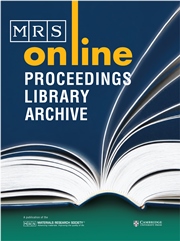Article contents
Preferential Site Precipitation and Subcell Stability in AA6061Sandwich Cores
Published online by Cambridge University Press: 26 February 2011
Abstract
Periodic cellular metal (PCM) sandwich cores can be considered hybrids ofthe solid and gas type. These can be designed at both the architectural andmicrostructural levels. PCM cores with 95% open porosity have beenconstructed from perforated 6061 aluminium alloy (AA6061) sheets using aperforation-stretching method. This method places planar,periodically-perforated sheet metal in an alternating-pin jig. The pinsapply force out-of-plane, plastically deforming the sheet metal into atruss-like array of struts (i.e. metal supports) and nodal peaks (i.e. strutintersections). The result is a non-uniform work-hardened profile exhibitinglarge deformation at the nodes and small deformation at the struts.
For identical PCM architectures, this study looks at the interaction ofmicrostructural strengthening mechanisms and the resultant performance ofPCM truss cores. Beginning with fabrication, work-hardening induced asubcell network of dislocation tangles within the AA6061 matrix. Followingthis stage, a variety of microstructures were created through recovery,recrystallization and precipitation mechanisms. Microhardness measurementsand electron back-scattered diffraction (EBSD) characterization wereemployed through truss core cross-sections in order to study themicrostructural gradients of subcell size as well as interaction betweensubcells and precipitates in the truss cores. To determine the effect ofmicrostructure on mechanical performance, PCM cores were compressed to studydeformation and collapse mechanisms.
The present data can be used to illustrate engineering at the architecturaland microstructural levels to achieve a range of mechanical properties in ahybrid sandwich core.
Information
- Type
- Research Article
- Information
- Copyright
- Copyright © Materials Research Society 2007
References
- 1
- Cited by

